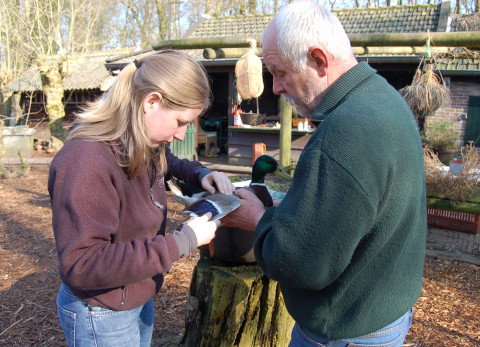Research among mallards proves: migratory birds don't import bird flu but contract it here

Research among mallards proves: migratory birds don't import bird flu but contract it here
Good to know: this study was not on H5N8 but mainly on a H3 flu subtype. Every subtype has its own dynamics, making general conclusions difficult.
Migratory birds are often blamed for spreading avian influenza. But new research proves for a specific flu type that instead of importing the virus into the Netherlands, migratory mallards actually contract it here. NIOO-researcher Jacintha van Dijk defends her thesis on the topic at Utrecht University on Wednesday.
Flu season is on the way...at least, if you're a mallard. "The pattern we've seen in the Netherlands", says Jacintha van Dijk, "is that bird flu peaks twice a year." There is a minor bird flu peak during the summer, as the number of vulnerable young ducks increases. And a major peak in autumn, coinciding with the arrival of migratory mallards.
"It is unlikely that these migratory mallards carry the virus with them", says Van Dijk. "The peak is rather caused by the fact that they are more susceptible to strains of the virus found in the Netherlands than Dutch mallards would be." Mallards that merely carry the virus don't have serious symptoms. They continue to fly around - although a bit less - and this way it could get spread around the area.
Mild strains of the bird flu virus have long been common in mallards and other waterfowl. It is only when such mild strains spread to poultry farms, that a high pathogene version of the virus may develop which also could infect humans. The exact connection between bird flu in wild birds and bird flu in poultry is by no means clear yet. For one thing, the flu peaks don't correspond: among poultry, the peak infection season is spring and not autumn.
The Netherlands is one of the main wintering areas for millions of waterfowl. The mallard (Anas platyrhynchos) is one of the species most often infected with bird flu. The researchers captured and sampled mallards at a duck decoy during one whole year, at an average frequency of once a week. This allowed Van Dijk to narrow down the timing of bird flu peaks. The origin of the birds was established through the chemical composition of their feathers (compared to feathers from 38 locations in Europe).
On Tuesday, one day ahead of Jacintha van Dijk's thesis defence, there will be a special symposium at the NIOO on the ecology of infectious diseases in natural populations.



